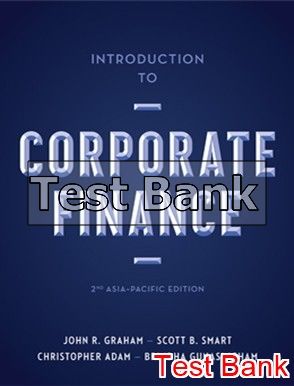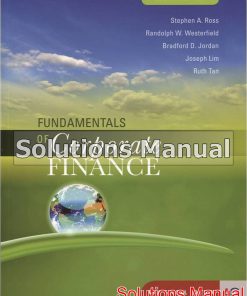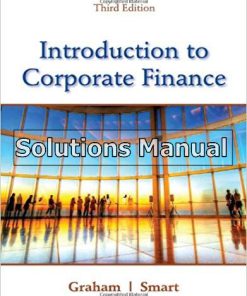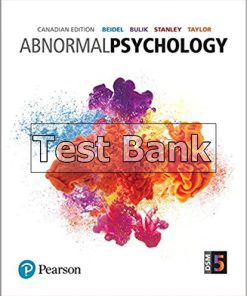Introduction to Corporate Finance Asia-Pacific 2nd Edition Graham Test Bank
$26.50$50.00 (-47%)
Introduction to Corporate Finance Asia-Pacific 2nd Edition Graham Test Bank.
You may also like
Introduction to Corporate Finance Asia-Pacific 2nd Edition Graham Test Bank

Product details:
- ISBN-10 : 017036433X
- ISBN-13 : 978-0170364331
- Author:
Corporate Finance, 3e offers a dynamic, modern and practical approach that illustrates how financial management really works and helps prepare you for a career in finance. It features up-to-date content including a focus on ethics in finance, following the Australian Royal Commission into Misconduct in the Banking, Superannuation and Financial Services Industry.
Table contents:
Part 1: Introduction
Chapter 1: The Scope of Corporate Finance
1.1 Corporate Finance Elements and Functions
1.1a Elements and Structure of Corporate Finance Learning
1.1b The Five Basic Corporate Finance Functions
1.1c Debt and Equity: The Two Flavours of Capital
1.1d The Role of Financial Intermediaries in Corporate Finance
1.2 Goals for the Corporate Financial Manager
1.2a What Should a Financial Manager Try to Maximise?
1.2b How Can Agency Costs be Controlled in Corporate Finance?
1.2c Ethics are Important in Corporate Finance
1.3 The Role of Corporate Finance in Business
1.3a How Finance Interacts with other Functional Business Areas
1.3b Legal Forms of Business Organisation
1.3c Special Forms of Business Organisation
1.4 Career Opportunities In Finance
1.4a Corporate Finance
1.4b Commercial Banking
1.4c Investment Banking
1.4d Money Management
1.4e Consulting
Study Tools
Problems
Case study: The Scope of Corporate Finance
Chapter 2: Financial Statement and Cash Flow Analysis
2.1 Financial Statements
2.1a Balance Sheet
2.1b Income Statement
2.1c Statement of Retained Earnings
2.1d Statement of Cash Flows
2.1e Notes to Financial Statements
2.2 Cash Flow Analysis
2.2a The Company’s Cash Flows
2.2b Developing and Interpreting the Statement of Cash Flows
2.3 Assessing Financial Performance Using Ratio Analysis
2.3a Using Financial Ratios
2.3b Liquidity Ratios
2.3c Activity Ratios
2.3d Debt Ratios
2.4 Profitability Ratios
2.4a Dupont System of Analysis
2.5 Market Ratios
2.6 Corporate Taxes
2.6a Ordinary Corporate Income
2.6b Corporate Capital Gains
Study tools
Problems
Case study: Financial Statement and Cash Flow Analysis
Chapter 3: The Time Value of Money
3.1 Introduction to the Time Value of Money
3.2 Future Value of a Lump Sum Received Today
3.2a The Concept of Future Value
3.2b The Equation for Future Value
3.2c A Graphic View of Future Value
3.3 Present Value of a Lump Sum Received in the Future
3.3a The Concept of Present Value
3.3b The Equation for Present Value
3.3c A Graphic View of Present Value
3.4 Additional Applications Involving Lump Sums
3.5 Future Value of Cash Flow Streams
3.5a Finding the Future Value of a Mixed Stream
3.5b Types of Annuities
3.5c Finding the Future Value of an Ordinary Annuity
3.5d Finding the Future Value of an Annuity Due
3.6 Present Value of Cash Flow Streams
3.6a Finding the Present Value of a Mixed Stream
3.6b Finding the Present Value of an Ordinary Annuity
3.6c Finding the Present Value of an Annuity Due
3.6d Finding the Present Value of a Perpetuity
3.6e Finding the Present Value of a Growing Perpetuity
3.7 Advanced Applications of Time Value
3.7a Compounding More Frequently than Annually
3.7b Stated Versus Effective Annual Interest Rates
3.7c Calculating Deposits Needed to Accumulate a Future Sum
3.7d Loan Amortisation
Study Tools
Problems
Case study: Present Value
Real-World Case Study: All in the Family
Sound Bites: Ethics in Corporate Finance – Part 1
Part 2: Valuation, Risk and Return
Chapter 4: Valuing Bonds
4.1 Valuation Basics
4.1a The Fundamental Valuation Model
4.2 Bond Prices and Interest Rates
4.2a Bond Vocabulary
4.2b The Basic Equation (Assuming Annual Interest)
4.2c Semiannual Compounding
4.2d Bond Prices and Interest Rates
4.3 Types of Bonds
4.3a By Issuer
4.3b By Features
4.4 Bond Markets
4.4a Bond-Price Quotations
4.4b Bond Ratings
4.5 The Term Structure of Interest Rates
4.5a The Yield Curve
4.5b Using the Yield Curve to Forecast Interest Rates
4.5c The Liquidity Preference and Preferred Habitat Theories
4.5d Conclusion
Study Tools
Problems
Case study: Bond Purchase Decision
Chapter 5: Valuing Shares
5.1 The Essential Features of Preferred and Ordinary Shares
5.2 Valuing Preferred and Ordinary Shares
5.2a Preferred Share Valuation
5.2b Ordinary Share Valuation Equation
5.2c Zero Growth
5.2d Constant Growth
5.2e Variable Growth
5.2f How to Estimate Growth
5.2g What If there are No Dividends?
5.3 The Free Cash Flow Approach to Ordinary Share Valuation
5.4 Other Approaches to Ordinary Share Valuation
5.4a Liquidation Value, Book Value and Residual Income Measurement
5.4b Market Multiples of Comparable Companies
5.5 Primary and Secondary Markets for Equity Securities
5.5a Investment Banking Functions and the Primary Market
5.5b Secondary Markets for Equity Securities
5.5c Social Investing through Equity
Study Tools
Problems
Case study: Valuing Shares
Chapter 6: The Trade-off Between Risk and Return
6.1 Understanding Returns
6.1a The Components of Total Return
6.1b Dollar Returns and Percentage Returns
6.2 The History of Returns (Or, How To Get Rich Slowly)
6.2a Nominal and Real Returns on Shares, Bonds and Bills
6.2b The Risk Dimension
6.3 Volatility and Risk
6.3a The Distribution of Historical Share Returns
6.3b The Variability of Equity Returns
6.4 The Power of Diversification
6.4a Systematic and Unsystematic Risk
6.4b Risk and Return Revisited
Study Tools
Problems
Case study: The Trade-Off between Risk and Return
Chapter 7: Risk, Return and the Capital Asset Pricing Model
7.1 Expected Returns
7.1a The Historical Approach
7.1b The Probabilistic Approach
7.1c The Risk-Based Approach
7.2 Risk and Return for Portfolios
7.2a Portfolio Expected Return
7.2b Portfolio Risk
7.3 Pulling It All Together: The CAPM
7.4 Are Share Returns Predictable?
Study Tools
Problems
Case study: Risk, Return and the Capital Asset Pricing Model (CAPM)
Chapter 8: Options
8.1 Options Vocabulary
8.1a Option Trading
8.1b Option Prices
8.2 Option Payoff Diagrams
8.2a Call Option Payoffs
8.2b Put Option Payoffs
8.2c Payoffs for Portfolios of Options and Other Securities
8.2d Put–Call Parity
8.3 Qualitative Analysis of Option Prices
8.3a Factors that Influence Option Values
8.4 Option Pricing Models
8.4a The Binomial Model
8.4b The Black–Scholes Model
8.5 Options In Corporate Finance
8.5a Employee Share Options
8.5b Warrants and Convertibles
8.5c Other Option Types
Study Tools
Problems
Case study: Options
Real-World Case Study: Sharing the Business
Sound Bites: Ethics in Corporate Finance – Part 2
Part 3: Capital Budgeting
Chapter 9: Capital Budgeting Process and Decision Criteria
9.1 Introduction to Capital Budgeting
9.1a Traits of Ideal Investment Criteria
9.1b A Capital Budgeting Problem
9.2 Net Present Value and Economic Value Added
9.2a Net Present Value Calculations
9.2b Pros and Cons of NPV
9.2c Economic Value Added
9.3 Internal Rate of Return
9.3a Finding a Project’s IRR
9.3b Advantages of the IRR Method
9.3c Problems with the Internal Rate of Return
9.3d IRR, NPV and Mutually Exclusive Projects
9.4 Profitability Index
9.4a Calculating the Profitability Index
9.5 Payback Methods
9.5a The Payback Decision Rule
9.5b Pros and Cons of the Payback Method
9.5c Discounted Payback
9.6 Accounting-Based Methods
9.6a Accounting Rate of Return
9.6b Pros and Cons of the Accounting Rate of Return
9.7 Capital Budgeting In Practice
9.7a Payback Period
9.7b Internal Rate of Return
9.7c Additional Analysis
9.7d Conclusion
Study Tools
Problems
Case study: Capital Budgeting Process and Techniques
Chapter 10: Cash Flow and Capital Budgeting
10.1 Types of Cash Flows
10.1a Cash Flow Versus Accounting Profit
10.1b Depreciation
10.1c Fixed Asset
10.1d Net Working Capital
10.1e Terminal Value
10.2 Incremental Cash Flows
10.2a Sunk Costs
10.2b Opportunity Costs
10.2c Cannibalisation
10.3 Cash Flows for Protect IT Ltd
10.3a Year 0 Cash Flow
10.3b Year 1 Cash Flow
10.3c Year 2 Cash Flow
10.3d Terminal Value
10.3e Protect IT Project NPV
10.4 Special Problems in Capital Budgeting
10.4a Capital Rationing
10.4b Equipment Replacement and Equivalent Annual Cost
10.4c Excess Capacity
10.5 The Human Face of Capital Budgeting
Study Tools
Problems
People also search:
Introduction to Corporate Finance Asia-Pacific 2nd
Introduction to Corporate Finance Asia-Pacific 2nd edition
Introduction to Corporate Finance Asia-Pacific 2nd pdf
Introduction to Corporate Finance Asia-Pacific 2nd pdf free
Introduction to Corporate Finance Asia-Pacific 2nd download scribd












